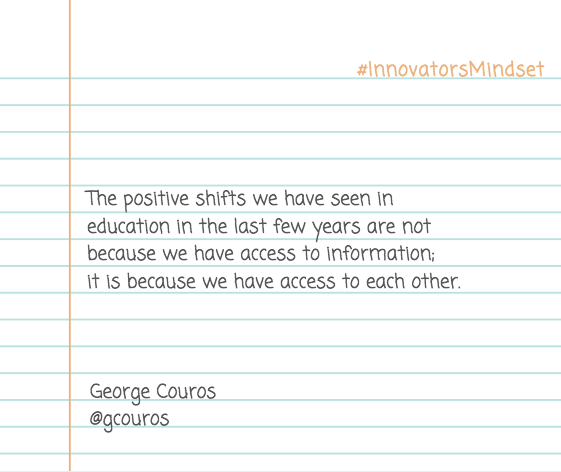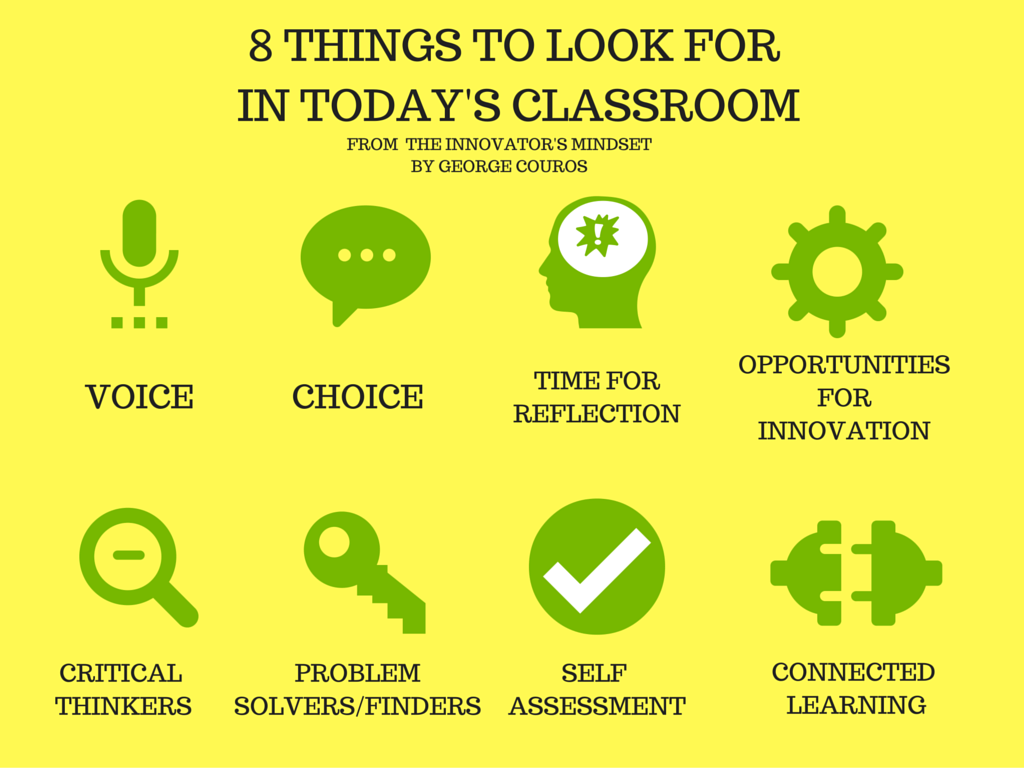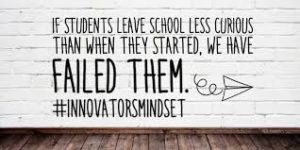
This is a compilation of some highlights in our first week of Innovator’s Mindset MOOC Round 2 #IMMOOC2. To join the conversation, check out IMMOOC.Org, #IMMOOC on Twitter, or join us on Facebook.
We have seen a great start to our #IMMOOC2 experience as many participants have connected, posted on Facebook, Tweeted and blogged. There are similar themes discovered in what participants are sharing.
What is the purpose of innovation?
George defines innovation as “a way of thinking that creates something new and better.” “That means that change for the sake of change is never good enough.”
In chapter 1 George reminds us that: “We couldn’t have innovative teaching and learning without first defining what that meant and how it could look for our teachers and students.” Using Simon Sinek’s inspiration of organizations needing to start with their “why” and then move toward the what and the how, George believes “education’s why is to develop learners and leaders who will create a better present and future.” He adds, “When forward-thinking schools encourage today’s learners to become creators and leaders I believe they, in turn, will create a better world.”
Charlie Gramatges (@cgramatges) has taken a step to bringing innovation that is new and better to his school.
“As an administrator, I must make time for the teachers who work in my division to grow as educators. It just so happens that I have introduced the “FedEx Day” concept to the middle school teachers this past week. In essence, I want them to pursue something innovative that will make them a better teacher (see a film, start a course, visit a school, etc.). I will teach their class while they are away researching their idea. Upon returning to school, my hope is that they have found something of the disruptive ilk. I want them to bring new and exciting into the classroom. As Couros states, if a student leaves a course without further questions or curiosity about the topic he or she experienced, then the teacher has not done adequate work throughout the school year. Asking tough questions about “how we do business” is the first step.
Why might innovation be crucial in education?
Andreea Stoica (@MrsStoica) mentions in her blog a reasoning behind why people fear innovation and why they must focus on the “important” and move the familiar “urgent” lower on our list.
“Seth Godin reminds us all that “there’s a queue of urgent things, all justifiable, all requiring you and you alone to handle them. And so you do, pushing off the important in favor of the urgent”. He also reminds us that our urgent to do lists, the familiar ones reinforce the feeling of competency many so desperately chase. Who would not want to feel competent in their job, in their career? However, this feeling of competency diverts the focus from the important, which in many cases is the INNOVATION in our jobs. Adults, just like students, are afraid to leave the comfort of the known environment. Focusing on the urgent day in and day out, ingrains hesitation in our thinking. The urgent become the well known, the familiar, the … EXPERTISE. We become really good at doing our job. The idealist in each one of us is left further and further behind.”
She adds,
“We ask our students to be life long learners. We ask them to use critical thinking skills, to reflect on their work and make plans for improvement. We owe it to them to do the same.”
And concludes with,
“In the meantime we can continue to feed the system, to nurture the bureaucracy, to focus on the urgent. Many will still do. However change is coming. We can chose to avoid it, we can choose to ignore it. But it is coming. We might as well chose to grow and have a say in the change that is INNOVATION.
Focus on the important.”
Here are a few Tweets from our first #IMMOOC chat answering why innovation is important in education. Jan North and David Caruthers answer that we must keep moving forward and not become extinct.
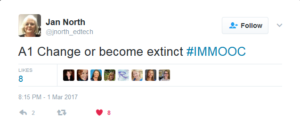
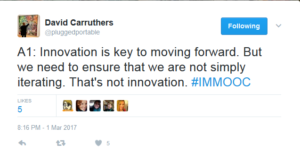
If you started school from scratch, what would you see as necessary, and what would you take out from what we currently do?
Michael Buist makes a convincing statement about having the foundation of trust in order to foster innovation. Trust is also the basis for moving forward in your IMMOOC experience.
“I get it. Trust is earned, never given. So it would take time to fill. But I’d never stop trying. I’d encourage everyone to try something new. To trust the process. To trust that failing is part of learning. That trust takes time and hard work and causes egos to be bruised and feelings to get hurt.
As the school is being filled with trust, it would become a place where everyone could take (responsible) risks. It would become a place where individual strengths would become collective strengths. Where weaknesses would lead to learning, to discovery, to passions being uncovered. School would become a place where people couldn’t wait to be and where no one would ever want to leave.”
Sue Bruyns (@sbruyns) joins the IMMOOC experience describing it as unconnected events magically coming together. If we were given a blank slate, how would we design an innovative classroom. Sue is in the perfect place to make this magic happen as she is in the process of designing a new elementary school in which she will be principal. In her blog she describes how the vision for this new school revolves around the conversation of “what if…”
“My new school journey has already started with an intentionality in terms of sharing a “what if” vision with potential staff members. Bringing together a team of educators who are willing to let go of past practice which isn’t meeting the needs of today’s students. Educators who are willing to embrace flexible seating, give up their standard metal teacher desk and imagine how a room lined with white boards can lead to student’s imagination. Creating a culture where everyone feels welcomed, needed and appreciated. A school where occasional teachers want to return to and parents are provided with an intentional role as partners in their child’s education. Student voice won’t be an event, it will be a non negotiable, whether through student generated video announcements, math talks, daily opportunities for collaboration with peers and student led conferences. Students who get to direct their learning through Project Based Learning and passion projects. A school culture where educators make their respect for the learners visible and audible. A school culture where everyday students will know that they are loved, respected and challenged. Technology will play a role in terms of accelerating the strong pedagogy and ensuring that all students can access the curriculum through multiple entry points. Intentional and purposeful purchases.”
Katie Martin and Tara Martin ask in the #IMMOOC chat how we would create an environment for students to wonder, explore and create. George Couros tells us to intentionally leave them frustrated. Katherine Goyette shows how we need to let students create their own space. Many participants were reactive to Michael Audevard‘s response to “build a culture where struggle is seen as opportunity and not embarrassment.”
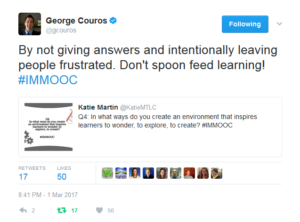

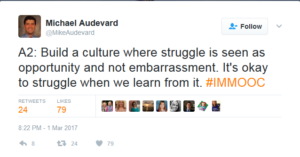
Did you happen to see Shawn Berry Clark‘s innovative way to respond to the #IMMOOC chat? Click on this link for her responses in raps. A Storify entitled “Innovation Stimulation: It’s a Rap!”
In chapter 1 George tells us: “When we think differently about the things that we are used to seeing daily, we can create innovative learning opportunities.”
The first Live Episode hosted by George Couros and Katie Martin included special guests and authors, A.J. Juliani and John Spencer, highlighting their book, LAUNCH.
The innovative mindset and design thinking framework are extensions of each other making this a perfect pairing for this first live session. We are reminded that students are curious in nature and we need to let them “go off road” , phrased by John Spencer, with it rather than giving them a recipe or too much scaffolding. We are told to begin this framework or mindset with guiding questions. Questions to ask ourselves, offered by Juliani and Spencer, for getting started included: What do I allow, support, make time for and praise? Why? Did you all have the same reflective moment when John Spencer recommended asking ourselves the question, What would you like to be doing in your classroom 5 years from now? Why don’t you start that today? Remember, the process is more important than the product.
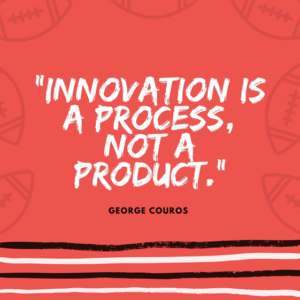
Joe Robison was impacted by the analogy given by John Spencer in his blog:
John Spencer (@spencerideas) gave one of the best analogies I’ve ever heard last night on #IMMOOC, comparing the love of baseball to school. It was one of those moments where I thought to myself, “that describes the state of our educational system exactly.” John’s analogy was:
“If someone had given me a rulebook, I never would have fallen in love with the game of baseball. I had to watch it, experience it and participate in it.”
Joe makes another connection later in his blog,
I am a firm believer this experience starts in the classroom, and spreads throughout the school. I cannot create an environment students want to be in if I marry my content to traditional methods day in and day out. Students know the game of school, and its time teachers introduce them to a new game with new experiences and new rules. For too long, we have only given students the rulebook without allowing them to experience the wonder and awe school can and should provide. This is where the concept of design thinking comes in, and the freedom each teacher has to create his or her own framework. The goal is to provide experience. If we provide the experience, students will fall in love with the process.
Boyd Weiger provided this popular Tweet where Katie Martin is quoted reminding us not to wait for permission if our innovative idea is great for kids:
Did you see Dana Murpy’s and Debbie Donski’s #sketchnotes on the live IMMOOC session?

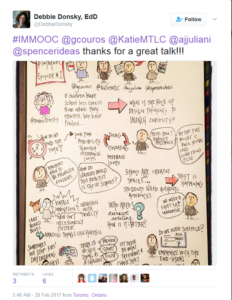
Stephanie Filardo summed up what our innovative speakers suggest as a place to start in this Twitter post:
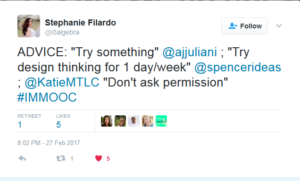
In a concluding thought, George states that we can be successful like organizations such as Starbucks, which continually look for ways to improve and meet the ever changing demands of consumers. Survival is more than the product; it’s about success. “In a world that constantly changes, if our focus is to only maintain what’s already been done, we are bound to become worse. The innovator’s mindset is necessary for all of us if schools are to move forward.” Why are we preparing students to make a difference in the world when they leave us when they can be doing that now.

Keep sharing your Tweets, Blogs and Facebook posts. We are better together and in the end the students are the winners,
Valerie









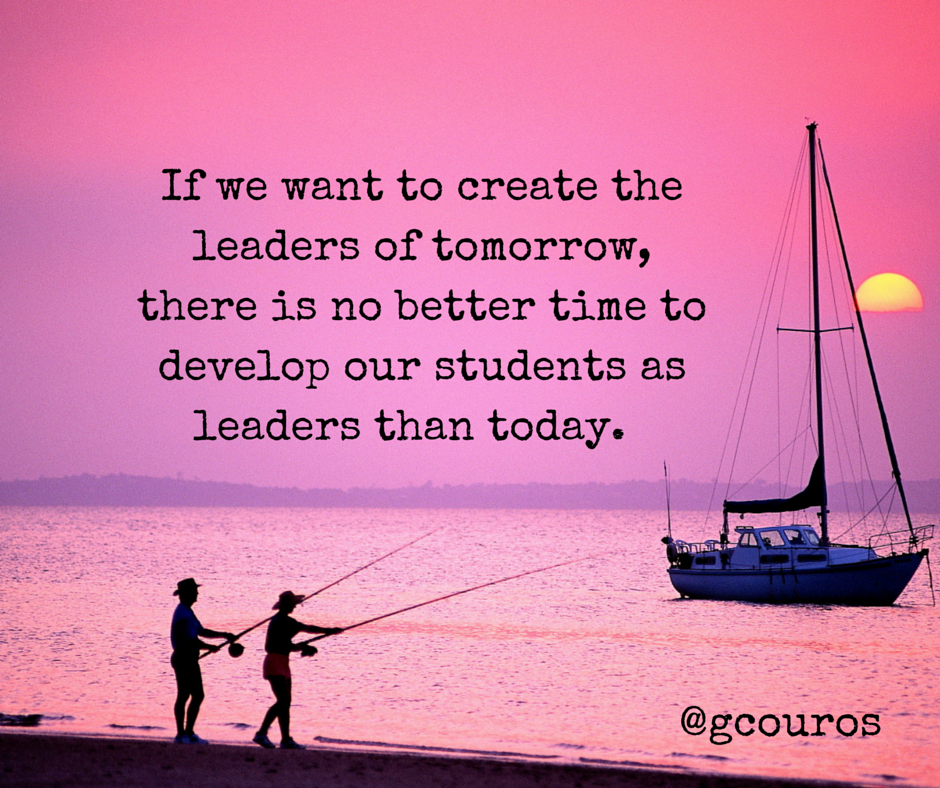
 This is a compilation of some highlights in our second week of Innovator’s Mindset MOOC Round 2 #IMMOOC2. To join the conversation, check out
This is a compilation of some highlights in our second week of Innovator’s Mindset MOOC Round 2 #IMMOOC2. To join the conversation, check out 



